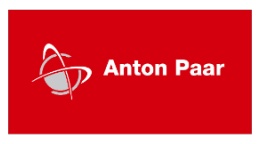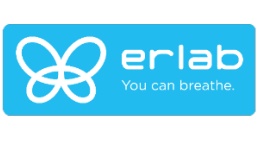方案详情文
智能文字提取功能测试中
Time-, Peak-,and Mass-BasedFraction Collection with theAgilent 1290 Infinity ll PreparativeOpen-Bed Fraction Collector Technical Overview Author Abstract Florian RieckAgilent Technologies, Inc. Waldbronn, Germany The Agilent 1290 Infinity II Preparative Open-Bed Fraction Collector sets newbenchmarks in efficient and flexible fraction collection. The fraction bed canbe equipped individually with six containers holding fraction tubes in eightdifferent sizes. Three drawers provide easy access to collected fractions evenduring a run. Peak- and time-based fraction modes have been extended to eightcombined modes, enabling the collection of volume or time slices, and includingtwo recovery collection modes. Trigger combinations of ultraviolet (UV) withmass-selective detection (MSD) signals now include an AND/OR logic that givesextra flexibility for challenging purifications. This Technical Overview provides adeeper insight and typical application examples of the fraction modes, includingcollection results. Agilent Technologies Introduction Fraction collection is the key feature thatturns an analytical high-performanceliquid chromatography (HPLC) system intoa purification system. Simple as it maysound, fraction collection in general,andpreparative-scale purification in particular,do have challenging facets. Flow ratesin preparative-scale HPLC range from5 up to 100 mL/min or above, generatingfraction volumes of below 1 mL up to tensor even hundreds of mL. This demandscollection vessels of different sizes, if thefraction collector capacity is to be usedin an optimal way. Quick processing ofcollected fractions (re-analysis, pooling,and solvent evaporation) is desirable,creating the need for an easily accessiblefraction bed. The Agilent 1290 Infinity II PreparativeOpen-Bed Fraction Collector' containsnew and improved features that addressall of these topics. Fraction containersholding tubes of different diameters(12, 16, 25, 30 mm) and lengths (100 or150 mm) are optimized to hold fractionsof 8 to 78 mL. The fraction bed can beequipped individually with six containers,and holds up to 432 single fractions, ora maximum fraction volume of 5,940 mL.Three drawers separate the fraction bed,and enable the exchange of full drawerseven during operation. Only the currentlyactive drawer is locked to prevent spillsand sample loss. Tubing kits with different insidediameters are available for optimizedsetup according to the flow rate used.As with the Agilent 1260 Infinity fractioncollectors, the 1290 Infinity II PreparativeOpen-Bed Fraction Collector features abuilt-in delay sensor, enabling precisecalibration of the delay between thedetector and the fraction valve withoutany hardware modifications. Along with hardware improvements, the1290 Infinity Il Preparative Open-BedFraction Collector offers several enhancedfraction collection modes that combinepeak-with time-based collection, andinclude recovery collections. Fractioncollection triggered by a combination of ultraviolet (UV) with mass-selectivedetection (MSD) signals has also beenextended by a third mode, combiningthe advantages of logical AND/ORconnections. This Technical Overviewdescribes the different fraction collectionmodes available in the 1290 Infinity IIPreparative Open-Bed Fraction Collector,and presents typical applications of thefeature enhancements. Experimental Instrumentation The Agilent 1260 InfinityPreparative-Scale Purification Systemconsisted of the following modules: Agilent 1260 Infinity PreparativePump Cluster (G1361A andG1391A) Agilent 1260 Infinity QuaternaryPump (G1311B) for MSD make-upflow Agilent 1260 Infinity Dual-LoopAutosampler (G2258A) equippedwith 50 pL (lower) and 5 mL(upper)injection loops Agilent 1260 Infinity Diode ArrayDetector (G1315C) equipped witha 3 mm Preparative Flow Cell(Option #22) Agilent 1290 Infinity Il PreparativeOpen-Bed Fraction Collector(G7159B) equipped with fractioncontainers for 16×150 mm(G9312-60129) and 12×100 mm(G9321-60045) tubes Agilent Active Flow Splitter(G1968F), connected through anAgilent 1200 Infinity UniversalInterface Box II (G1390B) Agilent 6150 Single QuadrupoleLC/MS with Agilent Jet Streamtechnology (G6150B) For fraction re-analysis, an Agilent 1260Infinity II Binary LC was used in aconfiguration as follows: Agilent 1260 Infinity II Binary Pump(G7112B) Agilent 1260 Infinity Il Vialsampler(G7129A) Agilent 1260 Infinity II Diode ArrayDetector (G7115A) equipped with a10 mm standard cell (G1315-60022) Columns Preparative columnAgilent ZORBAX SB-C18 PrepHT21.2×100 mm, 5 pm (p/n 880966-122.01) Analytical column Agilent ZORBAX SB-C184.6 ×50 mm, 5 pm (p/n 846975-902) Software The analytical system was controlled bythe Agilent OpenLAB CDS ChemStationEdition for LC and LC/MS Systems,version C.01.07 SR1 [110]. The preparativesystem was controlled by the samesoftware, version C.01.07 SR2 [257]. Solvents and samples LC grade acetonitrile was purchasedfrom Merck, Darmstadt, Germany. Freshultrapure water was obtained from aMilli-Q Integral system equipped witha 0.22 pm membrane point-of-usecartridge (Millipak). Formic acid, dimethylsulfoxide,and the eight components ofthe preparative sample were of analyticalgrade or higher, and purchased fromSigma-Aldrich, Taufkirchen, Germany. A sample was prepared froma mixture of acetaminophen,sulfamerazine sodium salt, caffeine,methylparaben,sulfadimethoxine,ethylparaben, propylparaben, andbenzyl-4-hydroxybenzoate, dissolved indimethyl sulfoxide to a final concentrationof 10 mg/mL. Chromatographic conditionsTable 1. Preparative gradient, used with a 21.2×100 mm, 5 pm column. Parameter Description Mobile phase A) 0.1 % Formic acid in water B) 0.1% Formic acid in acetonitrile Flow rate 25 mL/min Gradient Scouting gradient: Optimized gradient: 0.00 minutes-10 %B 0.00 minutes-10%B 0.60 minutes -10%B 0.60 minutes -10 %B 6.00 minutes -90 %B 7.00 minutes-70 %B 6.01 minutes -98 %B 7.01 minutes -98 %B 7.00 minutes -98 %B 8.00 minutes-98 %B 7.01 minutes-10%B 8.01 minutes -10 %B Stop time 8.50 minutes 9.50 minutes Injection volume 250 pL Detection UV 254 nm, no reference Peak width >0.05 minutes (5 Hz) Table 2. Analytical gradient for fraction re-analysis, used with a 4.6×50 mm, 5 pm column. Mobile phase A) 0.1 % Formic acid in water B) 0.1 % Formic acid in acetonitrile Flow rate 1.5 mL/min Gradient 0.00 minutes -10%B 0.30 minutes-10 %B 3.00 minutes -64%B 3.10 minutes-98 %B 4.10 minutes-98 %B 4.11 minutes -10 %B Stop time 5.50 minutes Injection volume 5pL Detection UV 254 nm, no reference Table 3. MSD Spray Chamber and Signal Settings. Parameter Description Make-up flow 1.5 mL/min Make-up solvent Methanol/water 80:20 + 0.1 % formic acid Spray chamber Agilent Jet Stream Electro Spray Signal 1 Positive scan 125-725 Fragmentor 125 V Signal 2 Negative scan 125-725 Fragmentor 125 V Nebulizer pressure 35 psig Drying gas temperature 300°C Sheath gas temperature 250°C Sheath gas flow 10.0 L/min Capillary voltage ±1,300 V Nozzle voltage ±2,000V Time-based collection withvolume slices A perfect separation of a crude sampleand purification of all desired compoundsrequires proper setting of fractioncollection parameters and the solventgradient. These parameters can only bedetermined by an experiment. In mostcases, however, the available amount ofsample will be too precious to be wastedfor a simple scouting experiment withoutfraction collection. For situations suchas this, the 1290 Infinity II PreparativeOpen-Bed Fraction Collector offersdifferent time-based fraction modes.collecting either predefined volumeor time intervals, or a fixed number offractions within a specified time. The preparative sample was separatedby ascouting gradient, described inTable 1. Fraction collection was set totime-based, collecting volume slices,defining 21 mL volume slices, which isthe maximum fill volume of 16×150 mmcollection tubes. This fraction collectionmode, being active from 0.00 to7.00 minutes, enabled unspecificcollection of all compounds into ninedifferent fractions (Figure 1). In additionto this first crude fraction collection, thecollected data can serve as a basis todetermine optimum time, threshold, andslope parameters for a more sophisticatedfraction collection. Based on this datafile, the fraction preview functionalityin the instrument control softwaresimulates how peak parameter changesaffect fraction collection in the followingpurification runs (Figure 2). In addition to volume slice collection,time-based fraction collection can alsobe combined with a collection of timeslices of definable duration. A third modecollects a user-specified number offractions spread over a certain timespan,defined in the timetable. Figure 1. Purification of a preparative sample using a scouting gradient and the time-based, collectingvolume slices fraction mode. Blue and red lines represent start and stop times of the nine collectedfractions, respectively. D Advanced Figure 2. Fraction collector method settings in Agilent OpenLAB CDS ChemStation Edition, displayingcollection timetable, available fraction modes, and fraction preview. The latter enables the user to reviewhow changes of threshold, slope, and time settings affect the fraction collection. Peak-based collection with volumeslice recovery Another approach for an unspecific fraction collection with a scoutinggradient is possible using the peak-basedwith volume slice recovery fractionmode. Here, users can estimate and enterbasic parameters for peak threshold andslope based on their experience andthe expected sample concentration, aswell as a recovery slice volume. Then,fraction collection will start with volumeslice recovery at the time specified inthe timetable. Whenever the signal risesabove the entered threshold or slopeparameters, the fraction mode switchesto peak-based, and collects distinctfractions depending on the signal. Thisway, the compounds of interest arecollected in single fractions, whereas thevolume slice recovery collection preventsany sample loss in case threshold/slopeparameters are improperly set. Figure 3 shows the chromatogram andfractions collected with this fractionmode. Similar to the simple time-basedfraction mode, the first and last twofractions are pure recovery, and do notcontain any major peaks. Each of theeight sample compounds was collected ina distinct fraction. Note that peak-basedcollection is prioritized over volume slicerecovery, causing the volume slicesbetween the peaks to be smaller than thespecified 21 mL. Collection start and stoptimes can also be defined in a timetable,enabling the collection of selected peaksonly. The second recovery collection modecombines peak-based fraction collectionwith time slices of user-definableduration. In addition to recoverycollection, the 1290 Infinity ll PreparativeOpen-Bed Fraction Collector featuresanother combination of peak-basedcollection with time or volume slices,which is described in the followingsection. Collection start 0.00 minutesCollection stop7.00 minutesVolume slice 21 mL20 mAU Figure 3. Purification of a preparative sample using a scouting gradient and the peak-based with volumeslice recovery fraction mode. The eight sample components were collected in distinct fractions while theremaining chromatogram was cut into volume slices of ≤21 mL. Peak-based collection withtime slices Finding the right peak threshold and slopeparameters to collect peaks with highestpurity without cutting too much of thefront and tail of the peak can be difficult.This challenging task is addressed by thepeak-based, collecting time slices andpeak-based, collecting volume slicesfraction modes. In either of these modes,parameters for peak threshold or slopehave to be defined, along with a time orvolume slice duration. As soon as thesignal rises above the threshold/slopeparameters,the fraction collector startscollecting, and cuts the peak into multiplefractions according to the user-definedslice duration/volume. This fraction modeenables the user to define conservativepeak threshold/slope parameters, anddecide after collection and reanalysiswhether the outmost fractions of thepeak front and tail shall be used ordiscarded due to insufficient purity. Figure 4 shows a clipping of achromatogram recorded with a gradientthat barely separates compounds 4 and 5intentionally. These two peaks werecollected using peak-based fractioncollection with 0.04 minute time slices.Both peaks were cut into nine sliceseach, triggered by a combination ofthreshold and upslope settings of 20 mAUand 20 mAU/s, respectively. In a separateexperiment, the purity of each fractionwas determined on an analytical system. Figure 5 shows an overlay of there-analysis chromatograms of the lastthree time slices of compound 4, andthe first two time slices of compound 5.Fraction 4.7 contains the purecompound 4, whereas the last two slices(4.8 and 4.9) already contain traces ofcompound 5. Similarly, the first volumeslice of compound 5 still contains tracesof compound 4. To achieve the highestpurity of both compound 4 and 5, theadjacent three fractions would have tobe discarded. The topics of peak purityand recovery of the 1290 Infinity IIPreparative Open-Bed Fraction Collectorare addressed in more detail in anotherTechnical Overview². Collection start 4.00 minutes Collection stop 5.15 minutes Time slice duration 0.04 minutes Figure 4. Purification of a preparative sample using an optimized gradient and the peak-based, collectingtime slices fraction mode (clipping). Compounds 4 and 5 are barely separated and collected in nine timeslices of 0.04 minutes each. Figure 5. Overlay of fraction re-analysis: fractions 4.7 to 5.2 were collected using the peak-based,collecting time slices fraction mode (see Figure 4). Re-analysis revealed traces of compound 5 in the lastfractions of compound 4, as well as traces of compound 4 in the first fraction of compound 5. Peak-based collection When the compounds of interest arewell-separated and suitable peakthreshold and slope parameters areknown, peak-based fraction collectionis the method of choice. This fractionmode can be activated for distinct timewindows or for the complete runtime,and collects only peaks that meetthe user-defined threshold or slopeparameters. The preparative sample was purifiedusing an optimized gradient andpeak-based fraction collection from4.00 to 7.50 minutes, thus discardingthe first three compounds. The signalthreshold was set to 20 mAU, andupslope and downslope to 20 mAU/sand 5 mAU/s, respectively. Thecombination of threshold with slopesettings allows a better separation of thefractions: if two peaks are not perfectlybaseline-separated and the valleylies above the threshold, both peakswould be combined into one fraction ifcollection were triggered by thresholdonly. However, with downslope andupslope parameters, the falling and risingsignal slope between two peaks triggersa separation into distinct fractions(Figure 6). As a plus, the upslopeparameter prevents a false trigger; incase the baseline slowly rises above thethreshold, fraction collection does notstart until a peak causes the signal to risewith a steep slope. Peak-based collection by UV andMSD signal For highest specificity, fraction collectioncan be triggered by a combination ofthe UV signal with the MSD signal ineach peak-based fraction mode. Multipletarget masses can be specified foreach run, either globally in the method,or specifically for each single samplein a sequence. In the MSD fractioncollection parameters, ion speciescan be selected from a list of frequentadducts (±H*,+Nat, +Cl, and so forth)or entered arbitrarily. With this fractionmode, compounds can be purified withthe highest specificity regardless ofoverlapping peaks or a complex samplematrix. The preparative sample was separatedusing a logical AND combination ofthe UV and MSD signals to collectcompound 5 with high specificity.Peak-based fraction collection was used,with the same UV trigger parametersas in the previous example. Anadditional MSD signal threshold wasset to 50,000 cps, with a sample targetmass of 310 Da. As ion species, onlyprotonation/deprotonation was selected,monitoring both the negative and positivesignal of the MSD. Figure 7 shows the resultingchromatogram with the fraction marksdisplayed in both the UV and MSD signal.Contrary to the previous example, notevery peak within the collection windowfrom 4.00 to 7.50 minutes was collected,but only the one exceeding both UV andMSD threshold settings. Figure 6. Purification of a preparative sample using an optimized gradient and the peak-based fractionmode, active from 4.00 to 7.50 minutes. Note that the impurity of compound 6 is separated from the mainpeak in a distinct fraction. Figure 7. Purification of a preparative sample using an optimized gradient and the peak-based fractionmode with a logical AND combination of the UV and MSD signals. The logical AND connection selectedin this example is the most restrictivemode, triggering the fraction start onlywhen both detector signals are abovethe threshold, but ending the fractionas soon as one of two detector signalsdrops below the settings. Alternatively,connecting UV and MSD signals with alogical OR condition causes the fractioncollection to start as soon as one ofthe detector signals rises above thethreshold. This mode can be unfavorablesince it triggers the collection of a peakif only the UV threshold is exceeded,thereby overriding the specificity of theMSD. The 1290 Infinity ll Preparative Open-BedFraction Collector supports a third logicalconnection of UV and MSD signals, whichis called AND/OR. This mode combinesthe advantages of both modes: fractioncollection is triggered highly specificallyby UV and MSD, starting only whenboth detector signals exceed the presetthreshold/slope settings. Collectioncontinues, however, until both detectorshave sent a stop signal. Contrary tothe AND connection, the AND/ORconnection allows for a greater peakwidth in the MS signal, and does not cutoff the fraction collection too soon. Ifthe specificity of an MSD is desired,thechoice between three logical connectionsof UV and MSD signals maintainsmaximum flexibility, and provides theoptimum solution for any given scenario. Conclusion Besides a larger capacity, and a muchmore flexible configuration of thefraction bed, the Agilent 1290 Infinity IlPreparative Open-Bed Fraction Collectoroffers new combined fraction modes thatare tailored to the demands of differentpurification challenges. This TechnicalOverview provides application examplesand collection outcomes of these fractionmodes, including time-based collectioncombined with volume slices, peak-basedcollection combined with time slices, andtwo recovery collection modes. Peak-based fraction collection is demonstratedwith a combination of ultraviolet (UV) andmass-selective detection (MSD) signals,connected by Boolean AND,as well asthe novel AND/OR logic. References 1. Agilent 1290 Infinity Il PreparativeOpen-Bed Fraction Collector-Collect Each and Every Drop,Agilent Technologies Brochure,publication number 5991-7225EN,2016. 2. Rieck, F. Performance Characteristicsof the 1290 Infinity ll PreparativeOpen-Bed Fraction Collector-Purity and Recovery of CollectedCompounds, Agilent TechnologiesTechnical Overview,publicationnumber5991-7655EN,2016. Abstract The Agilent 1290 Infinity II Preparative Open-Bed Fraction Collector sets new benchmarks in efficient and flexible fraction collection. The fraction bed can be equipped individually with six containers holding fraction tubes in eight different sizes. Three drawers provide easy access to collected fractions even during a run. Peak- and time-based fraction modes have been extended to eight combined modes, enabling the collection of volume or time slices, and including two recovery collection modes. Trigger combinations of ultraviolet (UV) with mass-selective detection (MSD) signals now include an AND/OR logic that gives extra flexibility for challenging purifications. This Technical Overview provides a deeper insight and typical application examples of the fraction modes, including collection results.IntroductionFraction collection is the key feature that turns an analytical high-performance liquid chromatography (HPLC) system into a purification system. Simple as it may sound, fraction collection in general, and preparative-scale purification in particular, do have challenging facets. Flow rates in preparative-scale HPLC range from 5 up to 100 mL/min or above, generating fraction volumes of below 1 mL up to tens or even hundreds of mL. This demands collection vessels of different sizes, if the fraction collector capacity is to be used in an optimal way. Quick processing of collected fractions (re-analysis, pooling, and solvent evaporation) is desirable, creating the need for an easily accessible fraction bed. The Agilent 1290 Infinity II Preparative Open-Bed Fraction Collector1 contains new and improved features that address all of these topics. Fraction containers holding tubes of different diameters (12, 16, 25, 30 mm) and lengths (100 or 150 mm) are optimized to hold fractions of 8 to 78 mL. The fraction bed can be equipped individually with six containers, and holds up to 432 single fractions, or a maximum fraction volume of 5,940 mL. Three drawers separate the fraction bed, and enable the exchange of full drawers even during operation. Only the currently active drawer is locked to prevent spills and sample loss. Tubing kits with different inside diameters are available for optimized setup according to the flow rate used. As with the Agilent 1260 Infinity fraction collectors, the 1290 Infinity II Preparative Open-Bed Fraction Collector features a built-in delay sensor, enabling precise calibration of the delay between the detector and the fraction valve without any hardware modifications. Along with hardware improvements, the 1290 Infinity II Preparative Open-Bed Fraction Collector offers several enhanced fraction collection modes that combine peak- with time-based collection, and include recovery collections. Fraction collection triggered by a combination of ultraviolet (UV) with mass-selective detection (MSD) signals has also been extended by a third mode, combining the advantages of logical AND/OR connections. This Technical Overview describes the different fraction collection modes available in the 1290 Infinity II Preparative Open-Bed Fraction Collector, and presents typical applications of the feature enhancements.ConclusionBesides a larger capacity, and a much more flexible configuration of the fraction bed, the Agilent 1290 Infinity II Preparative Open-Bed Fraction Collector offers new combined fraction modes that are tailored to the demands of different purification challenges. This Technical Overview provides application examples and collection outcomes of these fraction modes, including time-based collection combined with volume slices, peak-based collection combined with time slices, and two recovery collection modes. Peakbased fraction collection is demonstrated with a combination of ultraviolet (UV) and mass-selective detection (MSD) signals, connected by Boolean AND, as well as the novel AND/OR logic
关闭-
1/8
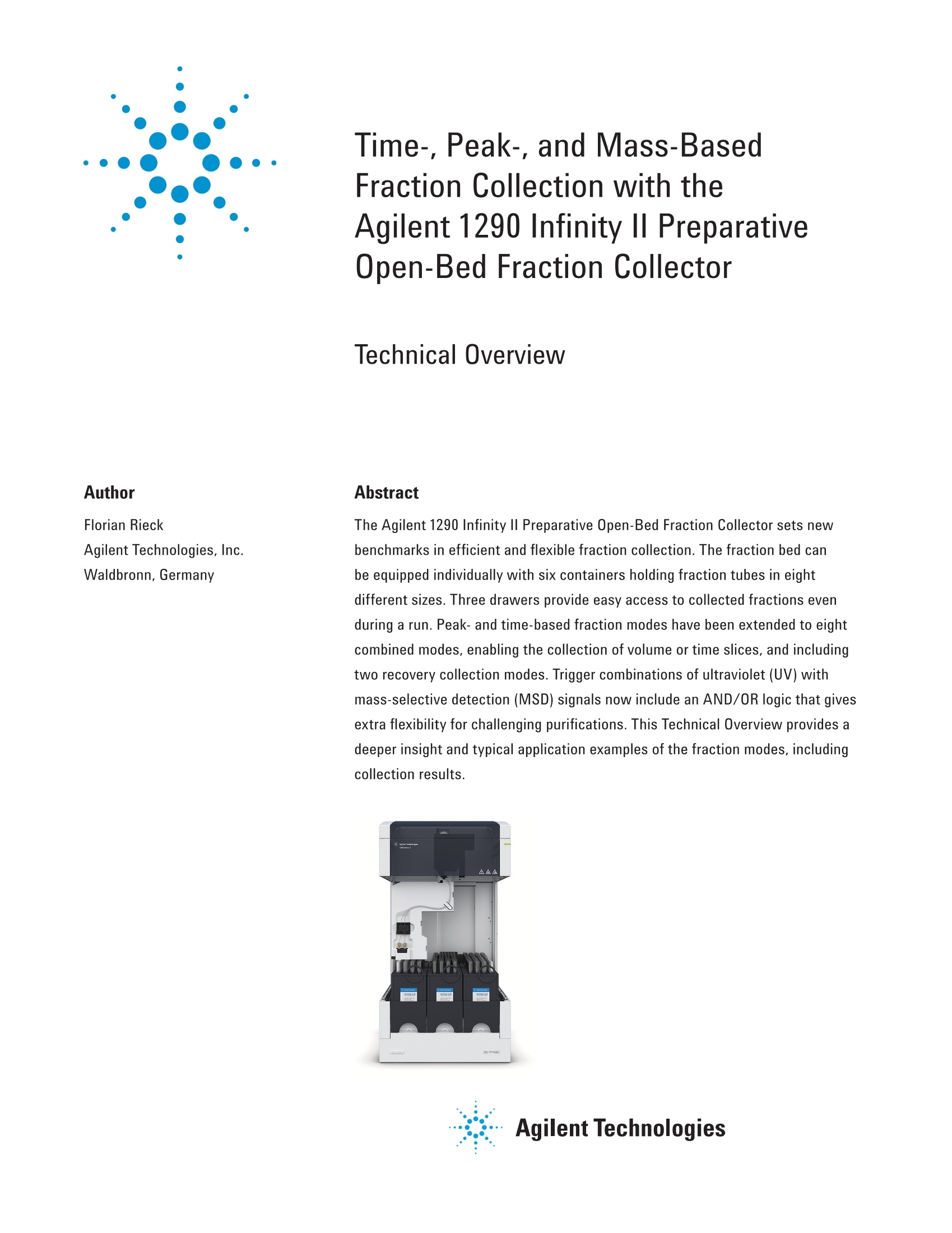
-
2/8
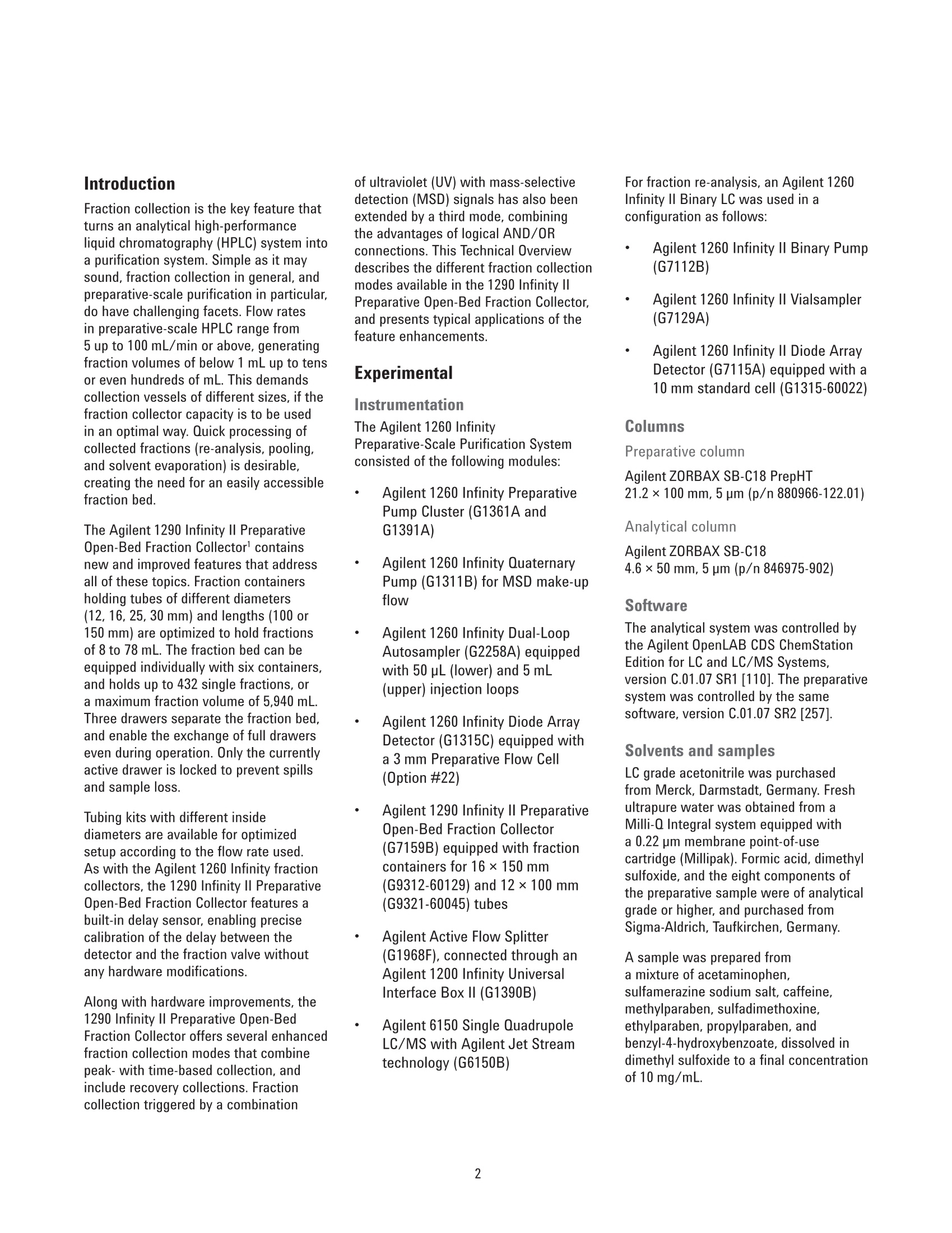
还剩6页未读,是否继续阅读?
继续免费阅读全文产品配置单
安捷伦科技(中国)有限公司为您提供《混合标样中乙酰氨基酚,磺胺甲嘧啶钠盐等检测方案(制备液相色谱)》,该方案主要用于其他中其他检测,参考标准《暂无》,《混合标样中乙酰氨基酚,磺胺甲嘧啶钠盐等检测方案(制备液相色谱)》用到的仪器有Agilent 1290 Infinity II 制备型液相色谱、Agilent 1290 Infinity II Multisampler。
我要纠错
相关方案


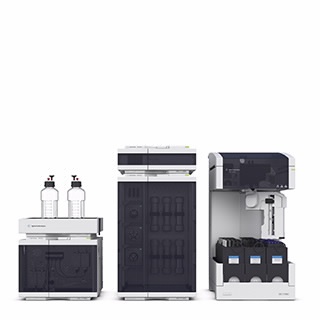
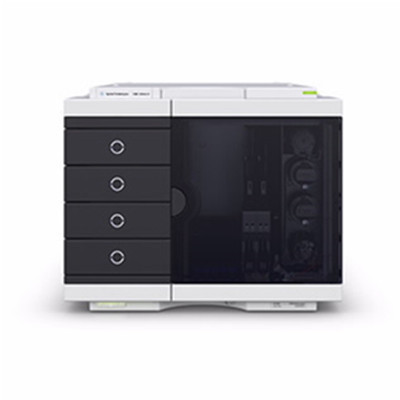
 咨询
咨询
